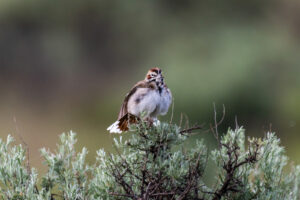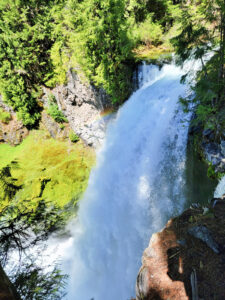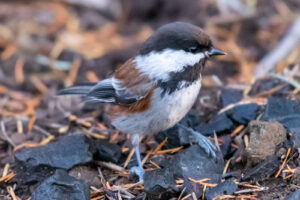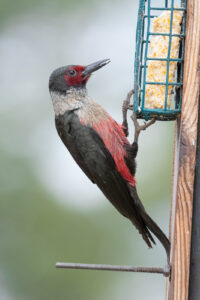Oregon: Malheur N.W.R. to the Pacific Seacoast

From Seabirds to the Sagebrush Sea
April 25 to May 3, 2025
$2,750 | ($500 deposit due upon registration)
Single Supplement: $470
8 participants max
N
estled in the heart of the Pacific Flyway, Oregon is an inspiring landscape drawn from a rugged fairytale. Its dramatic coastlines, iconic mountain rainforests, and endless sagebrush deserts comprise some of the most astonishing wildlife and legendary birdwatching in North America. We’ll awaken as dawn breaks over the sage within the Malheur National Wildlife Refuge, and watch western spring migrants filter through streamside cottonwoods above wetlands thick with shorebirds and waterfowl. Over the next eight days, we’ll explore westward from the sagebrush sea, over the Cascade Mountains, and down to the temperate rainforests and craggy ocean shores, where we’ll encounter strange and wonderful seabirds not found anywhere in the Atlantic. Although the journey explores the same latitude as Vermont, that is where the similarities end.
Additional Information
(Click each tab to expand)
Flow of the Day: The itinerary is designed to maximize our experience with the great diversity of birdlife and ecosystems that Oregon offers. On our birding trips, we don't rush from place to place chasing the largest species lists possible. Instead, our goal is to spend time appreciating birds and their habitats at an enjoyable pace that lets us understand their behavior and context within the ecosystem. We begin early early each morning, and we travel slowly to allow for the best bird and wildlife encounters.
Given that we are often between or far from lodging most days, we rarely have the opportunity for mid-day downtime at our accommodations (though more flexibility is possible while we are in Malheur NWR). Knowing this, we build in opportunities throughout each day for travelers to have some downtime, even if that's on the road or at a birding area.
Climate: Temperatures in Malheur NWR can vary drastically between night and day - early morning temps may be in the upper 30s, rising to the 60s or 70s by lunchtime. Temperatures will average warmer as we head west towards the coast, with afternoons also in the 60s and 70s, though the breeze from the Pacific can be a bit chilly.
Clothing: Pack field clothing of neutral colors. Bring several pairs of long pants and comfortable, long-sleeved shirts. Layers are a must! Long underwear, fleeces or wool sweaters, and wind-and-rain-proof outerwear are essential. A small umbrella is also recommended. Be sure to have a pair of comfortable, waterproof walking shoes or hiking boots, plus a second pair of light tennis shoes for long car rides and/or around town. You may want more casual clothing for traveling or dinners. A small washcloth and handkerchiefs will be helpful.
Equipment: Bring a pair of binoculars, a field guide, and a camera with extra batteries. The guides will have two spotting scopes. Pack sunglasses and sunscreen, a small flashlight or headlamp, a small alarm clock (a smartphone will work), insect repellent, a small daypack, and a small folding stool if you get tired standing for long periods observing birds and other wildlife.
Health Considerations: Dehydration and sun exposure are common issues in the arid intermountain West. Please come prepared to drink plenty of fluids and wear sunscreen. There are no vaccines or other travel-related medications that are typically administered for domestic travel to this destination. Tap water is safe to drink throughout the trip.
Physical Requirements: Participants should be able to hike on moderate terrain up to 3 miles per day on-and-off trail. Participants should be ready to expect conditions that may be hot, cold, dry, wet, or anything in-between. Restrooms may not be easily available out in the field at Malheur NWR, so participants needed frequent bathroom breaks may want to be comfortable using the "facili-trees."
Transportation: We will travel in either one 15-passenger van, or two minivans. Given the maximum group size of 8 participants, there should be plenty of room in the vehicle(s) to be comfortable.
Sean Beckett (he/him), Program Director at North Branch Nature Center, has worked extensively as a field ornithologist, researching Atlantic Puffins in Maine, Saw-whet Owls in New York, raptors in Idaho, Pygmy-Owls in Mexico, and Clark’s Nutcrackers in Wyoming. Sean has also been leading wildlife safaris around the world for the last ten years with NBNC, Natural Habitat Adventures, and the World Wildlife Fund, taking inquisitive travelers to the threshold of wolf dens, toe-to-toe with polar bears, into the African savannah, and through the heart of Utah’s canyonlands and deserts. Sean studied Biology and Environmental Studies as an undergrad, and received his M.S. from UVM’s Field Naturalist Program.
Rebecca Waterman (she/her) is a guest guide for NBNC's spring and fall birding outings, has been birding for 11 years and guiding for 7. In the summer of 2022, Rebecca moved to Vermont from Oregon, where she had lived for 18 years. In Oregon, she was a board member for her local Audubon Society, leading twice-monthly outings, Christmas Bird Counts, Global Big Day excursions, and private birding day trips. Rebecca loves the beauty and diversity of Oregon's landscapes and birds, and can't wait to share her home turf with you!
Malheur Field Station is a remote outpost in the middle of the sagebrush steppe that offers basic, dormitory-style lodging. Each traveler will have their own private bedroom, with shared dorm kitchen and bathrooms. Meals will be taken at the field station’s cafeteria, where we’ll have a hot breakfast and dinner each day and pack a lunch to-go. Given the station’s remoteness, the cafeteria can only accommodate certain dietary restrictions, so please reach out upon registration to inform us of your dietary needs. Our dormitory includes a shared kitchen where travelers can prepare meals if the cafeteria cannot accommodate (we will stop at a grocery store on our way to the refuge).
Our lodging everywhere else on the trip will be standard, American-style hotel rooms with private bedrooms and bathrooms. Meals outside of Malheur will vary between sit-down restaurants and take-out sandwiches/salads. Meals are planned to maximize our time birding, but we’ll certainly enjoy some nice restaurants along the way!
The trip cost includes:
- Pre-departure orientation gathering (virtual).
- Two expert guides.
- All accommodations.
- Entrance fees to parks.
- Comfortable, private transportation throughout the trip.
- Airport transfers.
- Meals at Malheur Field Station
- Carbon offsets for all airfare and travel to, from, and during this trip.
The trip cost does not include:
- Airfare
- Travel insurance
- Meals not at Malheur Field Station
- Alcoholic beverages, snacks and other incidentals
- Guide gratuities
NBNC is proud to announce that all of our trips from 2025 onward are 100% carbon-neutral. This includes each traveler's flights to and from this destination, as well as carbon emitted during the trip.
How it Works: The voluntary carbon market has come under intense scrutiny in recent years as the legitimacy and effectiveness of many carbon offsetting projects have been called into question. That's why we're proud to be working directly with the Northeast Wilderness Trust's Wild Carbon program. The carbon credits we purchase to offset our carbon emissions are used to permanently conserve forestland as wilderness. Why wilderness offsets?
- It's Permanent: Unlike most contracts in the voluntary carbon market that have a lifespan of just 10-20 years, wilderness conservation is forever.
- It's Additive: Acreage purchased and conserved through wild carbon offsets would not be protected anyway through another mechanism later.
- It's "Leakproof:" Forest protection often just shifts and concentrates timber harvest elsewhere. But wilderness conservation is different–wilderness protection here doesn't just move carbon emission over there. That's because old forests function very differently than young ones. Big trees and old soils capture and store vastly more carbon than a young forest of the same acreage. Growing an old forest is like building a natural carbon sequestration factory!
- It's More than Carbon: With wilderness protection comes additional co-benefits like biodiversity conservation, flood resilience, and habitat connectivity. This way, going carbon-neutral isn't just negating our carbon footprint, it's also actively helping conservation in other ways.
Want to learn more?:
- Read The Ecotourism Dilemma our article on how we think about carbon emissions in the context of nature travel.
- Check out this FAQ for NBNC travelers about Northeast Wilderness Trust's Wild Carbon Program.
- To learn more about forest carbon storage, please watch Understanding Forest Carbon by climate forester Dr. Ali Kosiba.
Ready to go to Oregon?
Email [email protected] to get signed up.
Payment Schedule
- A $500 deposit is required to reserve your space on the trip.
- 50% of the trip balance will be due 6 months before the departure date.
- The remaining trip balance will be due 3 months before the departure date.
All payments can be made via ACH withdrawal, or by check. Credit card payments will incur a 3% surcharge.
Cancellation Policies
We understand that incidents and emergencies arise that may force you to cancel your trip. However, NBNC invests considerable time and, in many cases, non-refundable payments to lodges and local contractors to secure our rooms and programming. NBNC aims to be as flexible as possible in our refund policy, but a full refund of your payments may not be possible after the dates indicated. All cancellations must be made via email to NBNC.
-
Cancellation more than 180 days before the trip: Full refund of all payments.
-
Cancellation 90-180 days before the trip: Refund of any payments minus the $500 deposit. If your space is filled by another traveler, we will also refund your deposit.
-
Cancellation 30-90 days before the trip: No refund guaranteed. If your space is filled by another traveler, we will provide a full refund minus the $500 deposit.
-
Cancellation less than 30 days before the trip: No refunds guaranteed.

Day by Day Itinerary
April 25 — Arrive in Boise, Idaho: We’ll pick up everyone from the Boise airport as folks arrive. We’ll convene at our hotel in the evening to head into town for a welcome dinner, where we can get to know each other and discuss the week ahead. For those interested in arriving in town a day early, the World Center for Birds of Prey and the Intermountain Bird Observatory are great local places to visit to learn about bird conservation in the intermountain West.
April 26 — To Malheur!: Malheur National Wildlife Refuge is about a half-day’s drive (with stops) from Boise. We’ll travel west from Boise through the Snake River Plain, a vast sagebrush steppe bounded by the dramatic Sawtooth Mountains to the east and the Cascades to the west. We will arrive in Malheur by early afternoon, where our first stop will be Malheur Visitor’s Center. Here, we can have great looks at Western Tanager, Great Horned Owl, many warbler species, Black-chinned Hummingbird, American Avocet, Willet, and much more. From there, we’ll bird our way through the refuge towards the Malheur Field Station, an outpost in the heart of the refuge where we will be settling in for the next several nights (see our Accommodations section for more info).
The Malheur National Wildlife Refuge is a key piece of the Pacific Flyway, and arguably the best birding to be found in Oregon. Nearly 300 species have been reported in the area. Huge flocks of migrating birds can be found, as well as rare visitors. The habitat and terrain varies dramatically - we will be near wetlands, cliffs, forests, salt flats, ponds, lakes, and sagebrush desert. This habitat diversity yields the abundance of wildlife for which Malheur NWR was established.
April 27-30 — Malheur National Wildlife Refuge: The next three full days will be spent exploring much of Malheur’s 187,000 acres. Though we have some must-see destinations within the refuge, your guides will be keeping a close eye on eBird and local chat groups for updates on where the most exciting activity is taking place. Besides the Visitor Center where we are likely to spend additional time, there are 36 other established eBird hotspots within the refuge around which we will orient our explorations. By basing ourselves out of the Malheur Field Station, we will be immersed all day in these ecosystems and birdlife.
Highlights in the refuge during this time of year include Snow Goose, Trumpeter Swan, Chukar, Common Poorwill, Sandhill Crane, Red-necked Phalarope, Black-crowned Night Heron, White-faced Ibis, Swainson’s Hawk, Ferruginous Hawk, Barn Owl, Western Screech-Owl, Burrowing Owl, Lewis’s Woodpecker, Prairie Falcon, Willow Flycatcher, Say’s Phoebe, Loggerhead Shrike, Rock Wren, Canyon Wren, Sage Thrasher, Mountain Bluebird, Townsend’s Solitaire, Brewer’s Sparrow, Black-throated Sparrow, Lark Sparrow, Sagebrush Sparrow, Western Meadowlark, Black-throated Gray Warbler, Townsend’s Warbler, and Lazuli Bunting.
April 30 — Through the Cascades: We will depart Malheur in the morning and drive a few hours to Prineville, where we may explore Crooked River Wetlands for a bit this morning. Here, we’ll walk a 1-mile paved loop path in search of Tundra Swan, ducks, Ring-necked Pheasant, White-throated Swift, shorebirds, gulls, Golden Eagle, Black-billed Magpie, Yellow-headed Blackbird, and more. After exploring the wetlands, we will continue our journey west, stopping in Sisters, OR, where we will have lunch, with the possibility of seeing White-headed Woodpecker, Pygmy Nuthatch, Mountain Chickadee, and Pinyon Jay right from town.
We'll then leave the desert behind and travel west towards Eugene, taking much of the afternoon to enjoy Oregon’s temperate rainforests. The high, dry desert of Eastern Oregon is the result of the “rain shadow” of the Cascade Mountains. Prevailing weather moving east off the ocean collides with the mountains here, creating lush, temperate rainforests iconic of the Pacific Northwest. We will visit Sahalie Falls, one of the most beautiful falls in Oregon, and only a short walk from the parking lot. Here we can search for flycatchers, swallows, wrens, America Dipper, Varied Thrush, and Hermit Warbler. We will arrive in Eugene late afternoon.
May 1 — Fern Ridge National Wildlife Refuge: We will start our day bright and early by traveling about 20 minutes west of town to one of the best birding spots in Western Oregon: Fern Ridge. This area features 5,000 acres of quite varied habitat, though we will be concentrating on two main access points to the marshy areas: Royal Ave Entrance and Fisher Butte. We will walk up to 3 miles on old dirt roads over the course of the morning. In the water here we’ll find almost every freshwater duck species in North America: Blue-winged, Cinnamon, and Green-winged Teals, Canvasback, Redhead, Ruddy Duck, and more. The refuge is home to a tremendous amount of other western birdlife, too: California Quail, Western Grebe, Virginia Rail, Sora, American Bittern, Black-necked Stilt, Long-billed Dowitcher, a few Tern species, large groups of American White Pelican, Northern Harrier, California Scrub-Jay, Western Wood-Pewee, Western Kingbird, Violet-green Swallow, Spotted Towhee, Western Bluebird, Yellow-breasted Chat, Acorn Woodpecker, and much more.
In the afternoon, we will continue on towards Florence, a picturesque seaside town with several must-see hotspots as well as a very cute and walkable downtown area. Hotspots include the South Jetty and several spots along the road to it, and the Port of Siuslaw Marina. Exploring these hotspots can bring us Cackling Goose, Western Grebe, Vaux’s Swift, Anna’s and Rufous Hummingbirds, Semipalmated Plover, Whimbrel, Short-billed Dowitcher, Wandering Tattler, Red Knot, Black Turnstone, Surfbird, Western Sandpiper, Rhinoceros Auklet, Marbled Murrelet, Pigeon Guillemot, and many more. Accommodations: Driftwood Shores, a 3 star hotel right on the seaside. Each room has a private patio or porch that overlooks the beach.
May 2 Pacific Seacoast Birding: We will depart Florence mid-morning and travel north along beautiful coastal Highway 101. The Oregon coast is full of dramatic views of rocky cliffs and the most famous sand dunes in the country. We will take our time, stopping along the way at places such as Depoe Bay, Ona Beach, and Heceta Head (home to the most photographed lighthouse in Oregon). Exploring these hotspots may reveal Rufous Hummingbird, Western Gull, Violet-Green Swallow, Wrentit, Pacific Wren, Western Grebe, Black Oystercatcher, Whimbrel, and many more shorebirds and seabirds. Our final destination for the day is Cannon Beach, where we can hope to observe Tufted Puffins on the iconic Haystack Rock.
May 3 Cannon Beach to Portland and flights home. There are many evening flights out of Portland, so we will take our time birding on the way into Portland today, arriving in the city in the early afternoon in time for evening departures. There are many hotspots within city limits to explore including the Portland Audubon Center (Anna’s Hummingbird, Red-breasted Sapsucker, Stellar’s Jay, Chestnut-backed Chickadee, Black-headed Grosbeak), the Portland Japanese Gardens, and plenty of sightseeing opportunities such as Powell’s Bookstore, OMSI, and several great shopping districts. Portland is a large, bustling city with a rich variety of birds and people, and a great place to spend a couple extra days after our birding adventure!


713 Elm Street
Montpelier, Vermont 05602
(802) 229-6206
Hours: Center Open Monday-Friday 9-4
Trails Open 24/7
























